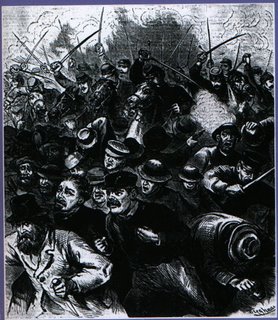 The labor unions used to be a plague on the United States. They were extremely violent in the 1880’s and ‘90s, and practically ruled business in the U.S. until Ronald Reagan stopped them with his fortitude. They are still very influential in Europe.
The labor unions used to be a plague on the United States. They were extremely violent in the 1880’s and ‘90s, and practically ruled business in the U.S. until Ronald Reagan stopped them with his fortitude. They are still very influential in Europe.One of the things that I have thought is very interesting is that the main fight of labor unions is not against employers, though that is part of it, but against other non-union employees.
Unionism is based on socialism. They probably wouldn’t say it outright, but they believe in the basic doctrine of Karl Marx’s communism: that the common workers are being oppressed by the employers and/or capitalists. This is based on Marx’s labor theory of value: that an object receives all of its value from the labor put into it. According to Marx, the workers do most of the wealth producing, but they receive very little of the benefits; the employers and capitalists do. Thus there is a great injustice.
Now, that’s not very good economics. There are many other factors in value besides the labor put into the product. Anyway, the unionists believed this basic communist premise, and set about to get for themselves more of what they saw as the profits of their labor. So they joined together and used intimidation to get better wages, fewer work hours, etc. from their employers.
The conflict comes to a head when the unions get those terms of easy work. They attempt to establish a monopoly on the labor in a certain field of expertise. They try to make the employers agree to only accept union members as employees. They exclude and take violent action against those who are willing to work for the standards and wages of the company, rather than the union. When the union calls a strike, they try to prevent other workers (called by the unionists “scabs”, “rats”, or “strikebreakers”) from coming to the company to relieve the labor shortage. This is when violence takes place.
If you look at the episodes of the 1880’s and ‘90s, you see what kind of things labor unions can do when they have the opportunity. You can see some of the crazy ideology that they put forward. Just read some of the accounts of the Great Railway Strike of 1877, or the Haymarket Riot of 1886, or the Homestead Strike of 1892, or the Pullman Strike of 1894. The unions have moderated in terms of violence since then, but the basic ideology is the same.
After WWII until the 80s, the unions had almost established complete control over large companies. They wielded so much power of the strike with all their members that the large companies were forced to bargain out deals or face a massive strike that would devastate their company. This carried on until Ronald Reagan came into office. He decided that enough was enough and that government was going to stand up to these people, at least the government employees.
When the Air Traffic Controller’s Association struck in 1981, Reagan just held out and refilled the posts with spare workers and willing controllers that agreed to work extra hours. After a while, the union members started to come back to the job because they couldn’t hold out without money for long. Then the private companies got the idea and started doing the same thing. Over the years, they gradually broke a large amount of the power of the labor unions.
No comments:
Post a Comment